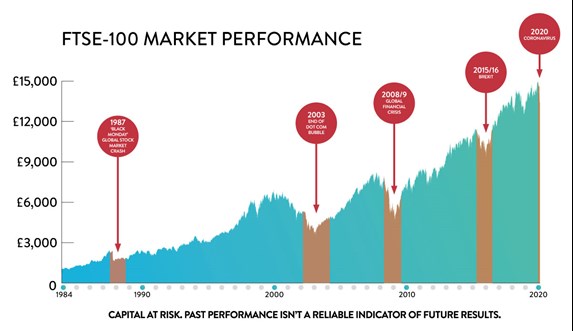Market bumps are more common than you may think – for instance, between 1984 and 2019, the FTSE 100 had 9 years of negative returns1. But guess what? The UK market always recovered from these drops. Obviously, we don’t know what the future holds and there could be an exception. However, if we look back, financial markets around the world tend to bounce back and here’s why.
Do financial markets always bounce back?
Unfortunately, we don’t have a crystal ball, so we can’t say when markets will bounce back. But if you look at how markets behaved in the past, you’ll notice an interesting pattern. For the past two decades, global markets fell many times – and even went through one of the worst financial crisis in history. And yet, the drops never lasted, and stock markets always recovered. Take the FTSE 100 for example. In 2008, the FTSE 100 dropped by more than 30%. However, the following year, the UK market was back up 22.1%2. And that’s not the only time the FTSE 100 rose after a big dip. Here’s how the FTSE 100 performed between 1984 and start of 2020.

One lesson to take from this is that it’s important to try and keep calm when markets fall. If you stop investing and sell your investments, you could miss out on potential growth. Say, you had invested £10,000 in the FTSE 100 at the start of 2000 and remained invested through the financial crisis of 2008, and until the end of 2019, you could have ended up with about £21,255, meaning your money could have grown on average by 5.4% on an annual basis (including reinvested dividends)3. It’s never nice to see markets go down, but when it does happen, it’s important to try and keep calm and remain focused on your long-term objectives. In fact, the longer you stick with your investments, the more likely you are to see positive growth. For example, people who invested in the FSTE 100 for any time period between 1986 and December 2019, have had an 89% chance of making a gain – and remember, this time period was marked by a number of market downturns4.
Why do markets tend to recover?
When financial markers fall, governments around the world tend to take action to help restore them – after all, it’s not in their interest to see markets crash and the economy deteriorate. So, every time markets are in trouble, central banks and governments will try to implement exceptional measures in order to stimulate the economy. One thing they almost always do is devalue cash. In other words, they try to make saving less attractive by cutting interest rates. That way, people are more likely to consume and put their savings somewhere else. Such measures are also taken to urge investors to remain invested and choose riskier investments, like shares. Because although they tend to fluctuate more than cash or bonds, over the long-term, shares could potentially deliver higher returns.
Buying shares when markets are down may feel a bit counter-intuitive, but it could be a wise move. Falling markets mean that investments are cheaper to buy, so why not take advantage of the situation and grab some bargains? If markets go back up, the cheap investments you bought could see their value increase and you could potentially make a healthily profit. A good way to make the most of market bumps is to consider investing little and often. By drip feeding, you could pick up some cheap investments if markets drop which could in turn smooth out the bumps – we’ve got a blog explaining how drip feeding works if you want to learn more about it. With Wealthify, getting your Plan topped up regularly is easier than you may think! Simply set up a Direct Debit and enjoy the ride.
References:
1: Total return data from Bloomberg
2: https://www.forecast-chart.com/historical-ftse-100.html
3: Data from Bloomberg
4: Data from Bloomberg
Past performance is not a reliable indicator of future results.
Please remember the value of your investments can go down as well as up, and you could get back less than invested.



